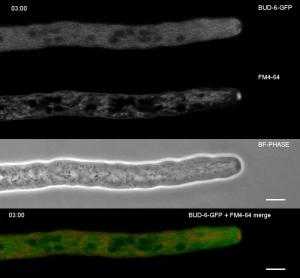Spitzenkörper

The Spitzenkörper is a structure found in fungal hyphae which is the organizing center for hyphal growth and morphogenesis. It consists of many small vesicles and is present in growing hyphal tips, during spore germination and where branch formation occurs. Its position in the hyphal tip correlates with the direction of hyphal growth. The spitzenkörper is a part of the endomembrane system in fungi.[1]
The vesicles are organized around a central area that contains a dense meshwork of microfilaments. Polysomes are often found closely to the posterior boundary of the Spitzenkörper core, microtubules extend into and often through the Spitzenkörper and Woronin bodies are found in the apical region near the Spitzenkörper.[2]
The cytoplasm of the extreme apex is occupied almost exclusively by secretory vesicles and microvesicles. In the higher fungi (Asco- and Basidiomycota), the former are arranged as a spherical shell around the latter, and the entire formation is called the Spitzenkörper or ‘apical body’. The Spitzenkorper may be seen in growing hyphae even with the light microscope. Hyphae of the Oomycota and some lower Eumycota (notably the Zygomycota) do not contain a recognizable Spitzenkörper, and the vesicles are instead distributed more loosely in the apical dome.[3]
References
- ↑ Steinberg, G. (2007). "Hyphal growth: a tale of motors, lipids, and the spitzenkörper". Eukaryotic Cell 6 (3): 351–360. doi:10.1128/EC.00381-06. PMC 1828937. PMID 17259546.
- ↑ Harris, S.; Read, N.; Roberson, R.; Shaw, B.; Seiler, S.; Plamann, M.; Momany, M. (2005). "Polarisome meets spitzenkörper: microscopy, genetics, and genomics converge". Eukaryotic cell 4 (2): 225–229. doi:10.1128/EC.4.2.225-229.2005. PMC 549335. PMID 15701784.
- ↑ Webster, John; Weber, R. W. S. (2007). Introduction to Fungi (Third ed.). New York: Cambridge University Press. ISBN 0-521-80739-5.
| Wikimedia Commons has media related to Spitzenkörper. |